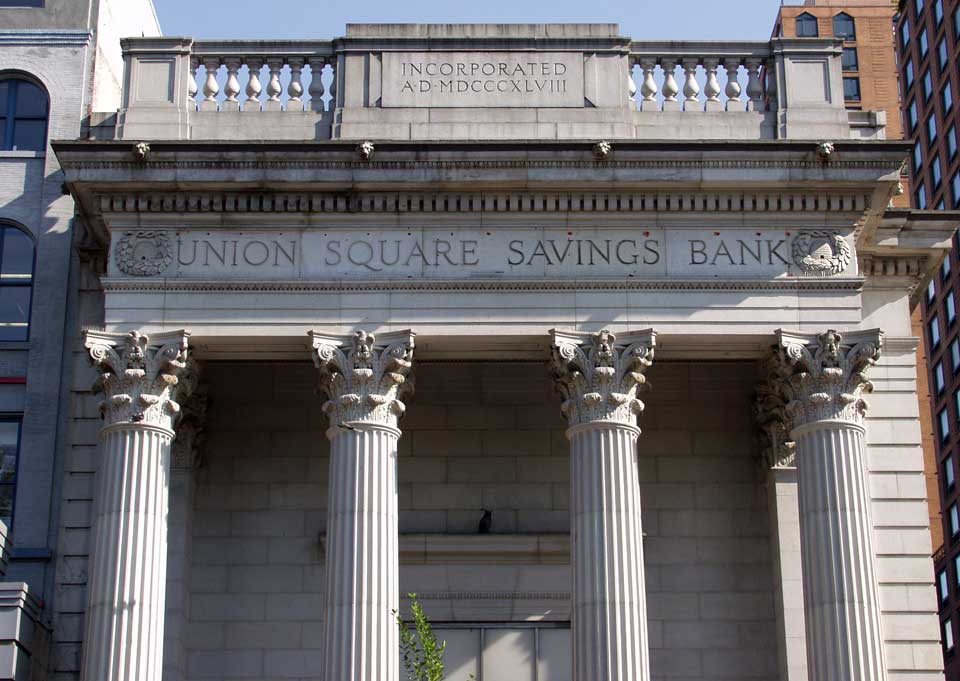
Union Square Savings Bank, 20 Union Square East, northeast corner of 15th Street (2004)

The balustrade reads "Incorporated AD 1848." However, a sign in gold gilt on the front wall clarifies: "Formerly Institution For the Savings of Merchants' Clerks / Incorporated April 12 1848" (click for image).
The website www.banking.state.ny.us offers the following sequence:
The entry for The Institution for the Savings of Merchants' Clerks
in Moses King's Handbook of New York City (1892) reads in part,
"Incorporated in 1848, it [the Institution] has had a dignifiedly quiet and uniformly
steady growth ever since. As its name implies, it was founded to encourage the
clerks of business men to take care of their earnings... The bank has had but
five presidents, James G. King, Moses H. Grinnell, A. Gracie King, Joseph W.
Patterson, and Col. Andrew Warner. Col Warner has been connected with the bank
for 38 consecutive years, first in 1854 as Cashier, afterwards in 1855 as Cashier
and Secretary, and later in 1881 as President...
"The bank's earliest quarters were in the old Clinton Hall, at the corner of Beekman
and Nassau Streets. Later they were at 516 Broadway, opposite the old St. Nicholas
Hotel; and in 1868 the present Union-Square property was bought and remodeled to
its uses." King's "present property" of 1892 was replaced in 1905-07 by the building
shown above.
This portrait of Andrew Warner appeared in Moses King's Notable New Yorkers of 1896-1899 (1899).
The Office for Metropolitan History, "Manhattan NB Database 1900-1986," (10 June 2009), http://www.MetroHistory.com describes the building as "Year: 1905; NB#: 1686; Cost: $275,000.00; Address: Union sq, Nos 20-22; 1 and 4-sty brk and stone bank and apartments 52 x 125; Owner: Union Square Savings Bank / Union sq and 15th st; Architect: Henry Bacon / 160 5th [Fifth] av."
The AIA Guide to New York, 4th ed. (2000), by Norval White and Elliot Willensky says, "A classy Corinthian colonnade is somewhat forlorn in these precincts. Bacon's best remembrance is the Lincoln Memorial."
The building is an officially designated New York City Landmark. New York City Landmarks, 4th ed. (2009), with text by Andrew S. Dolkart and Matthew A. Postal, reads, "The bold academic classicism of this white granite bank building with its Corinthian temple front reveals the design aesthetic of Henry Bacon, an architect best known for the monumental Lincoln Memorial in Washington, D. C. The Institution for the Savings of Merchants' Clerks, established in 1848, was renamed the Union Square Savings Bank in 1904. The bank remained an independent institution until 1968, when it merged with another bank."
Robert A. M. Stern, et. al., New York 1900: Metropolitan Architecture and Urbanism 1890-1915, (1983), write, "In his design for the Union Square Savings Bank (1907) at 20 Union Square, on the northeast corner of East Fifteenth Street, Henry Bacon adapted the robust Classicism and general parti of McKim's Knickerbocker Trust Company to a small corner site. Four lushly modelled Corinthian columns supporting a cornice and balustrade formed a porch facing the square, while along Fifteenth Street pilasters alternated with tall windows."
A photo in the New York Public Library digital gallery shows the Union Square Savings Bank in 1933. The bank nestles up to a branch of Klein's Dept. Store along Union Square East (click for image). A painted sign for the bank appears on the next building east along 15th St. An earlier image dated 1930 shows this same building without the sign (click for image).
This image of 20 Union Square East is dated ca. 1977 when the bank had become the United Mutual Savings Bank. Part of the collections of the Museum of the City of New York, this is a photo by Edmund V. Gillon, Jr., who did the photographs in Margot Gayle's Cast-Iron Architecture in New York (1974).
< previous || next > index map signs by date signs by name see what's new